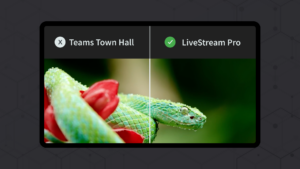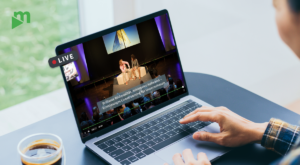What is a Livestreaming Platform – Definition
First of all, a short definition: A livestreaming platform allows users to record video content in real time and send it to their viewers via the Internet or intranet.
Especially in the context of sports and gaming, livestreams are very popular, think for example of platforms like Twitch or YouTube, which provide hundreds of millions of users with live video content every month.
In the wake of the Corona pandemic, livestreaming has also become significantly more important in the B2B sector. Internal communication in many companies has shifted to the home, product demos have been held digitally, and hybrid and virtual events have become the standard in the event industry.
To date, streaming video content has evolved for many companies from a savior in an emergency to an integral part of their communication strategies.
What types of livestreaming are there?
Livestreaming applications are as diverse as any other form of communication. Yet modern livestreaming platforms offer many features that go beyond simply sharing live video, making livestreaming a valuable alternative for many physical events.
Some of our customers’ favorite applications include:
Employee & Management Communication.
Transparent, direct and accessible communication across all levels of the organization is key to success for businesses of all sizes.
The right use of a livestreaming platform ensures that employees and teams are effectively reached and informed regardless of location.
Company speeches, all-hands meetings or town halls, as well as internal product demos are among the most frequently streamed content in companies today.
Product releases
Apple has been doing it for years, and many companies are finally following suit: product releases via livestream.
Apart from the seemingly unlimited reach, livestreams offer many practical advantages for your next launch.
For example, everything is recorded directly and can be used immediately afterwards. If your streaming platform has interaction features, you can also get immediate feedback from your audience.
In addition, some platforms have built-in analytics that allow you to track exactly who has watched your stream and use that information to generate new leads.
Annual General Meetings and Investor Relations
Transparent and direct communication is essential not only within the company, but also with investors and stakeholders.
Livestreaming platforms such as our LiveStream Pro rely heavily on security and privacy features to ensure that your important information only gets where it needs to go.
Live Shopping
What has been successful at QVC for years now enables record sales with a breath of fresh air on the Internet: Live Shopping.
Anyone who is now skeptical can be convinced by the statistics. For example, the sale of products via livestreaming platform is expected to account for nearly 20% of all eCommerce sales in China by 2026!
However, companies in Europe and North America are also seeing a lot of success with the virtual sales channel today.
While B2C brands mainly rely on streaming via social channels such as Instagram, B2B-focused corporations and brands are creating the right framework for scalable sales events online with livestreaming platforms for hybrid or virtual events.
Other use cases include:
- Live Webinars
- Q&As
- Interviews
- Behind the Scenes Insights
- Sweepstakes & Raffles
- Corporate Events
- Shareholder Meeting
- Let’s Play Streams
What should you look for when choosing a live streaming platform?
A high expectation is not wrong at this point. Nevertheless, there are a few basic characteristics in which the various livestreaming platforms differ – both in the range of functions and in the areas of application.
Before we get to the list of providers, we’ll show the what you should look for when choosing a livestreaming platform.
Security & privacy
Depending on the use case and target group, the protection of your livestream and the data of your participants plays an essential role.
Especially streaming video content in a corporate context requires special security features, such as SSL encryption, login and password protection, geo-blocking, or anonymization.
Compliance with DSGVO / GDPR standards should also be taken into account by companies when live streaming.
Livestream Analytics
Analytics and monitoring features allow you to accurately evaluate your live event. You can track how your audience interacted with your stream.
Key livestream metrics that can be tracked include number of viewers, location information, device information, stream duration / viewer dwell time, and interactions.
Content Delivery Network (CDN)
A Content Delivery Network is essential if you want to stream your video content within an enterprise network.
A CDN allows you to deliver a high-quality live stream with minimal delay and high quality even under special network conditions.
Video monetization capabilities
From embedding advertising content to pay-per-view features, there are a variety of ways to make money from your stream, depending on the streaming platform and use case.
Professional video hosting and video content management
If you want to save your content after the live broadcast and make it easily and conveniently accessible for your viewers, your livestreaming platform should have integrated video hosting.
A professional video content management system allows you to easily manage, edit and share your content.
Other features:
- Video editing tools
- Low-latency streaming for delay-free video transmission
- RTMP (Real-Time Messaging Protocol) support for recording, playback, and streaming
- Live streaming APIs for third-party app integration
- Cloud video encoding and transcoding
The best premium livestreaming platforms in 2023
No. 1: movingimage LiveStream Pro

The movingimage live streaming solution has been specially developed to meet the specific requirements of modern companies, large corporations and agencies in Europe.
The core features of the LiveStream Pro streaming platform include:
- Comprehensive security and data protection features
- DSGVO-compliant streaming
- Full-HD streaming
- High scalability
- Integrated eCDN
- Interactive features, such as chats, polls, Q&As
- Customizable design
- Optional streaming support from our in-house film production team
Working closely with our clients, the solution also meets the high standards of the pharmaceutical, financial and automotive industries.
For information on the cost of the LiveStream Pro, please visit the product page.
Ideal for:
The streaming platform is particularly suitable for usage in corporate communications, be it for town hall meetings, annual general meetings, presentations or product launches.
No. 2: Panopto
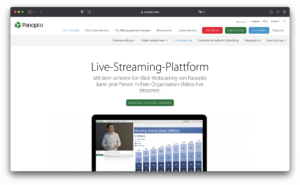
Panopto is an American provider of a video platform on which videos can be managed centrally and streamed live.
The platform is geared towards the needs of educational institutions and is particularly suitable for eLearning applications and the internal streaming of video content.
The platform’s features include:
- Interactive elements
- Simple branding options
- Quiz function
- Livestream recording
- Integration of apps
- Rights & Roles
There is no information about the pricing. However, the company does provide a free trial version to those interested.
Ideal for:
The platform is used primarily by U.S. educational institutions, offering them a virtual classroom, video management and video content recording.
Nr. 3: Dacast
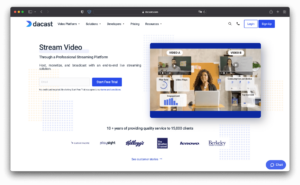
Dacast is an online video and hosting solution with the possibility of embedding livestreams into your own website, thus preserving your corporate design.
The platform is widely used to stream video to a large, public audience. The functionality of the streaming platform includes:
- Password protection
- Livestream analytics
- Paywall monetization
- Broadcasting without advertising
- Around-the-clock support
- Player API access for integrating third-party players
The only negative here is the lack of flexibility in handling additional interactive features.
Dacast offers several plans; Starting with the Basic plan for $19 per month, up to the Enterprise plan for $289 per month.
Ideal for:
Small businesses looking for an entry-level solution to stream content publicly without a lot of bells and whistles, but also without a lot of customization options.
No. 4: Brightcove
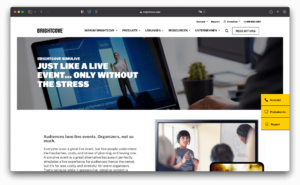
Brightcove is another American provider of enterprise video solutions. The streaming platform is particularly used by media and entertainment companies and is therefore primarily used for public event streaming.
Features of the Brightcove livestreaming platform include:
- Video Cloud Hosting
- High scalability
- Monetization
- Livestream analytics
- Video API access
- CRM Integration
Brightcove provides current pricing information for the streaming solution only upon request.
Ideal for:
Brightcove’s streaming solutions are used by media and entertainment organizations, as well as a variety of other cultural and arts institutions.
Nr. 5: Vimeo Live
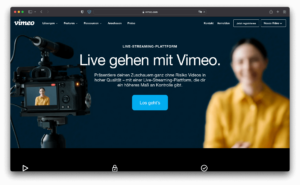
Vimeo’s video platform is known as an ad-free competitor to YouTube and has also appeared as a live streaming provider since 2017 through the acquisition of the live streaming platform Mogulus. The price range is very extensive. Depending on which tariff one opts for, various features are available, such as:
- Customizability of the video player
- SimulCast for different platforms
- advanced privacy options
- large storage capacity
- general video management
- livestream analytics
- Pay-per-view option
Prices start from $7 per month and end at $75 per month.
Ideal for:
Filmmakers, artists and other creatives are often identified as the main target audience for Vimeo. Because of the low price, it’s great for individuals and small businesses.
No. 6: Kaltura
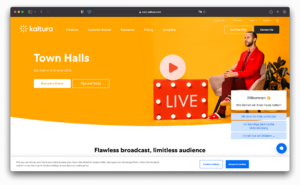
The streaming platform of the American provider Kaltura established itself more than a decade ago as an open source video solution for large companies and corporations. The complex configuration options require some technical expertise, but also offer a lot of flexibility in the application areas.
The features of the Kaltura streaming solution include:
- numerous add-ons
- Security features
- Monetization options
- Video API access
Information on the cost of the Kaltura Streaming platform is available upon request only.
Ideal for:
Kaltura’s streaming solution is marketed primarily to educational institutions telecommunications and media companies.
Nr. 7: IBM Cloud Video
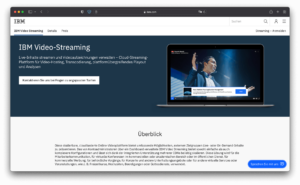
IBM Cloud is considered an end-to-end solution for live and on-demand content, allowing users to communicate in all kinds of environments, from employee communications to virtual conferences.
The cloud-based online video player brings with it several useful features. Among them:
- Interactive tools
- Monetization capabilities
- CDN
- OTT video management
- Single sign-on
Pro rates for the IBM Cloud Video Livestreaming Platform range from $99 – $999 per month.
Ideal for:
Enterprises and event organizers.
Nr. 8: Qumu
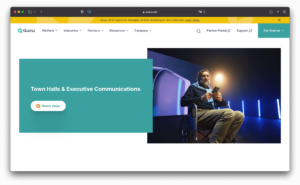
US company Qumu also offers customers a seamless video CMS for both on-demand and live streaming. The technology used can be described as powerful, but is geared more towards internal communication applications. In addition, important features such as white labeling, password protection, custom branding or embedding videos with domain restrictions are not possible. To use videos for your external marketing and communications, you’ll need a separate subscription and system to manage them.
Among the features:
- Built-in CDN for delivering the highest quality videos.
- Multicast and peer-to-peer
- Optimizes content for device, network, file type, and bit rate
- Ten thousand simultaneous users are no problem
- Embeddable widgets to share live and recorded video across any video medium
Ideal for:
Qumu’s streaming solution is used by American software companies and IT service providers.
Nr. 9: Muvi
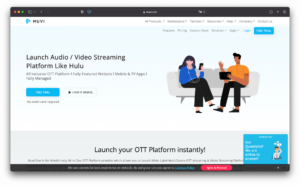
Livestream provider Muvi is developing a comprehensive OTT streaming platform for businesses. In addition to its own white-label website with a custom domain, features include:
- mobile and TV apps
- integrated SEO tools
- multiple payment gateways
- low latency streaming
- Interactive presentations
The standard tariff can be booked for 319 dollars per month. This includes 2000 simultaneous streaming participants as well as 1 TB bandwidth and storage space. The Professional plan for 1199 dollars per month increases the limits and provides premium support. The most expensive plan is the Enterprise plan for $3120 per month. This one offers even more features on top and advertises more customization.
Ideal for:
Businesses and large enterprises benefit from Muvi’s services. Depending on the tariff, capacities can be increased and adapted to the needs of large corporations.
The best free livestreaming platforms in 2023
No. 10: Facebook Live
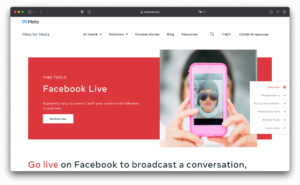
Facebook is the world’s largest social network, with around 2.8 billion active users. In 2019, Facebook announced that it would focus on original and engaging video content. You can live stream from your business page, personal profile or Facebook group, depending on the type of content you want to publish.
Livestream features include:
- Automatic saving and publishing of your streams
- Real-time comments and reactions to your stream
- Scheduling live events up to a week in advance of the stream
- Notifying followers before the event
You don’t have to spend money to livestream. Facebook is funded by ad revenue on the site.
You also have the option to earn money by monetizing your streams and videos. However, the following requirements must be met. You must…
- Live in certain countries around the world; there are 48 on the list so far.
- Be over the age of 18.
- Comply with the monetization guidelines for affiliates.
- have more than 10,000 followers.
- have at least five active videos on the site.
- 600,000 minutes of video views in the last 60 days, including 60,000 minutes of live video if you want to advertise on your live content.
Ideal for:
Local businesses and Influencer:ins that can already boast a large number of Facebook followers.
Nr. 11: Instagram Live
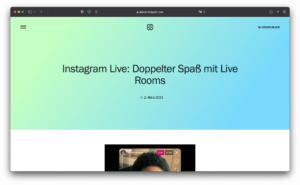
On July 01, 2021, Instagram chief Adam Mosseri announced that Instagram is at a turning point and from now on will not only focus on photos, but also increasingly support video content.
Livestreams can be started as easy as pie by simply swiping over the buttons for posts, stories and reels and then tapping the button to go live instantly. Livestreamers on Instagram can use the following features of the livestreaming solution:
- Invite people to your live feed with a notification once it’s started
- Filters or overlays for your video so that your live stream benefits from a VHS look, effects or funny faces, for example
- Badges that your followers can buy to be highlighted in your comments section
Like Facebook, there are no costs, neither for viewers nor for live streamers. Instagram makes money by selling ad space in your feed.
Ideal for:
Influencers and brands in the areas of fitness, lifestyle, beauty, fashion or health.
Nr. 12: YouTube Live
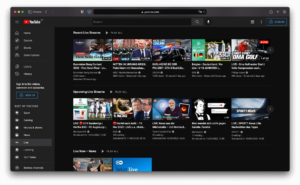
YouTube is still the world’s most popular video platform. Every day, about one billion hours of videos are viewed (about 115740 years). The number of active users per day is about 2.56 billion. In addition to the on-demand video platform, YouTube also offers a livestreaming solution with YouTube Live.
What you should know about YouTube Live:
- You need at least 1,000 subscribers to go live via your mobile app
- You can stream live via your webcam or use an encoder that is ideal for broadcasting your screen
- You get powerful real-time analytics of your livestream and can look at how many people are watching and interacting
Worth mentioning: once you’re done setting up your livestream, you can embed it anywhere on the web, such as your website or other social networks.
Streaming live on YouTube is free, but you have to accept some compromises:
- You don’t get any user data
- YouTube’s branding will always be visible on your video content
- You are only entitled to a share of the revenue from video advertising
- There is always a risk of demonetization
Ideal for:
Any person who wants to make their videos available to as many viewers:inside as possible. With a live stream limit of 8 hours, YouTube is ideal for hosting live event streams.
Nr. 13: LinkedIn Live
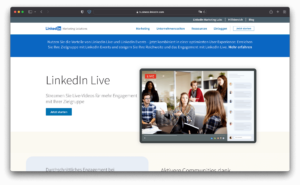
LinkedIn also has a livestream function. If you are wondering where to find it, you will probably search in vain at first.
In a first step, you have to apply for it and fulfill the following criteria:
- You must have at least 150 followers or connections.
- You already share articles and other self-created content on LinkedIn.
- You must adhere to LinkedIn’s Professional Community Policies.
- You must not be a resident of mainland China
When using LinkedIn Live, you have the choice to stream from your company account or your personal account. The following features are available to you:
- You can offer your viewers a chat to discuss the topic in advance.
- You can let your viewers submit questions in advance.
- Host a live chat during the event, which is also visible during the replay.
- You can see all LinkedIn reactions in your stream in real time
With LinkedIn in general, you benefit from an average young audience (60% between 25-34 years old) with attractive income ($46,000 per year).
To use LinkedIn Live, you don’t have to pay anything.
Ideal for:
LinkedIn is the ideal platform for B2B companies, consultants and freelancers who want to reach (potential) business partners.
Nr. 14: TikTok Live
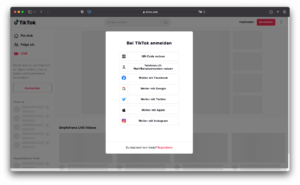
As the latest trending app, TikTok has recently added the ability to stream live video content. Viewers can discover your event/livestream, sign up for it, get notified about it, or receive reminders about the event.
Livestreamers on TikTok benefit from these features:
- Picture-in-Picture, so that you as a streamer:in don’t lose viewers so easily.
- Go LIVE Together, which means you can have more than one person in a stream, as the name suggests.
- Q&A sessions, so that users can ask you questions.
- A “Top LIVEs” category to make your live content easier to discover
- The option to add help or a moderator to your livestream
- Keyword filters for comment moderation and a prompt for comment writers to reconsider their unkind words
Once again, TikTok is completely free to use. Monetization options are also available. But to do so, these criteria must be met:
- Be based in the UK, US, France, Germany, Spain or Italy.
- Be over 18 years old
- Have 10,000 followers or more
- generate more than 100,000 video views in the last month
- Be in compliance with TikTok’s community guidelines.
Ideal for:
Lifestyle brands in particular can benefit from TikTok’s high reach and fast-paced nature.
Nr. 15: Twitch
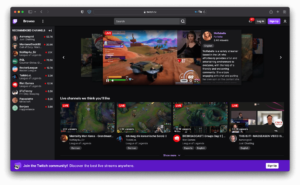
The live streaming platform Twitch is the most popular place for live broadcasts of video games and eSports events.
The focus is on interaction between the streamer and the audience.
The streaming platform offers many interaction elements:
- Emotes
- Live comments
- Subscriber badges
- Cheermotes
and much more. There are basically no costs for viewers or streamers.
However, the Livestream platform offers some monetization opportunities. The following requirements must be met:
- 500 minutes of live streamed content in the last month
- 7 single live streams in the period of the last month
- An average of 3 viewers in each stream in the last month
- At least 50 followers
Ideal for:
Streamers:ins and brands who are in the rapidly growing gaming industry and want to be in direct contact with their communities.
Nr. 16: Amazon Live
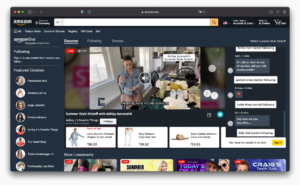
As the parent company of Twitch, Amazon has no need to tackle the same streaming market with gaming. Amazon is much more focused on the shopping sector.
$58 billion in revenue alone was generated in Q2 2021 for products sold directly to customers.
There is a huge potential audience for live stream shopping, with around 2.7 billion visits per month to Amazon.com in the US alone.
With Amazon’s streaming platform, you can:
- Conduct product demonstrations
- Share your screen with viewers
- Start a live chat to encourage interaction
- Encourage your viewers to click a “follow” button for your brand
- Set up a carousel of featured items so your viewers can buy your products immediately
Simply streaming on Amazon Live is free.
As an Amazon Influencer, you’ll even earn a commission on products sold during your live stream.
Ideal for:
The Creator App for Amazon Live is currently only available to brands and influencers in the US.
What equipment do I need for a live streaming video platform?
Choosing the right streaming equipment is as varied as choosing the right livestreaming platform. Ultimately, it all depends on what you want to achieve with your stream.
The minimum equipment, however, includes:
Conclusion
Choosing the right livestreaming platform can be a real challenge. Agencies, corporations, brands and influencers all have different needs and goals.
So when comparing livestreaming platforms, it’s important to understand which features are essential for streaming success before you even begin your search.
One platform is not necessarily better than another – they all have different functions, target groups and technical aspects.
We hope our overview has given you a good introduction to the world of livestreaming solutions.
Want to learn more about how to use livestreaming effectively and securely in your organization? Click here to watch the movingimage LiveStream Pro.
movingimage LiveStream Pro



























